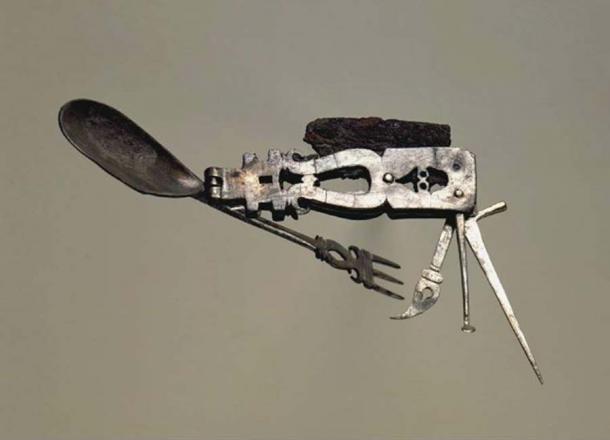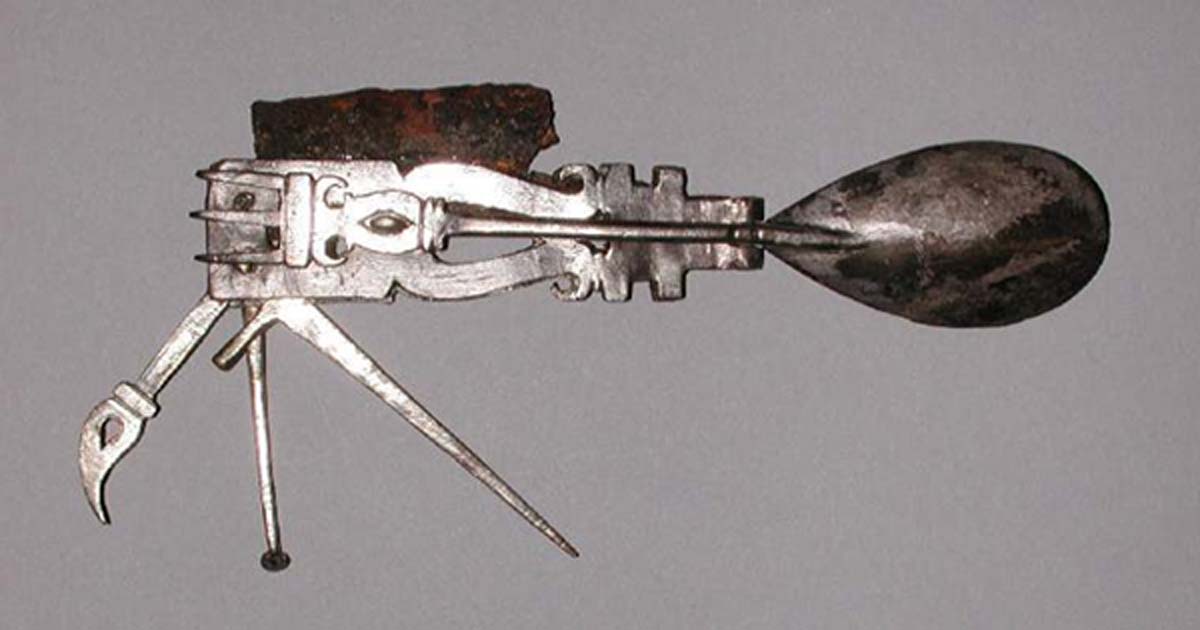The Original Swiss Army Knife: Check Out This Must Have Gadget for Guys on the Go
The modern Swiss Army Knife didn’t make its debut until the nineteenth century, revolutionizing convenient tools on the go. But, as with so many other things, the ancient Romans did it first! Meet the so-called “multi-tool,” a handy, fold-up device that contained a mini knife, spatula, fork, toothpick, and spike. Crafted in the third century AD, the tool could be toted around by a Roman soldier in his pocket while trekking through dangerous territory.
The most elaborate example is currently housed in the Fitzwilliam Museum in Cambridge, England. All the museum has publicly announced about its find-spot is that the piece was found in“the Mediterranean,” and in a 1988 article on the find, classicist David Sherlock noted, “I have not been able to find out anything about its provenance prior to c. 1980 when it was acquired by a dealer in Switzerland.”
The tiny gadget is made of iron and silver, expensive materials that turned this from an average doo-dad into a luxury. A Fitzwilliam Museum spokesperson told The Daily Mail in 2010 that it was “perhaps a useful gadget for a wealthy traveler.” The multi-tool’s owner would not necessarily have been a Roman. Perhaps he or she got the gadget through Rome’s extensive trade networks, well-established by the imperial period.

The iron and silver gadget would have had a wealthy owner. (Image: © The Fitzwilliam Museum)
But it would have proven particularly useful for a Roman soldier. Whether schlepping through enemy territory or setting up camp, soldiers had a lot on their backs. A military kit—including supplies, armor, and weapons—was extraordinarily heavy for your Average Joe (ranging from 30 to 100 pounds (13.5-45 kg), perhaps averaging around 60lb (27kg)), although whether a regular foot soldier could have afforded or would have owned this type of luxury item is up for debate. Regardless of the owner’s actual status, a soldier didn’t have much room for spare knick-knacks in his pack, or sarcina (Roman marching pack), so something combining the most essential tools, or instrument, would surely have been most welcome.
- Wootz Steel: The Mysterious Metal that Was Used in Deadly Damascus Blades
- Pick Your Poison: The AK-47 of the Ancient Near East
- Gladiator Helmets: Fit for Purpose, Not Just Protection

Detail of sarcina (marching pack). From the cast of Trajan's column in the Victoria and Albert museum, London. (Public Domain)
The fork, spoon, and knife are pretty self-explanatory, though the fork was a very rare utensil for the Romans to use. But what about the spike and the spatula? What could these unusual implements have been used for? As it turns out, those, too, were probably connected to food. The spike might have been employed to pry meat out of snails, modeled after spoons with pointy handles that served the same purpose. Sherlock observed that it “would not be strong enough for prising open oysters.”
The spatula looks a bit different from the pancake-flipper American readers might imagine. Instead, Roman spatulas were flat, elongated pieces of metal attached to long handles, which a soldier could use to help treat a wound or get a cork or bottle top off a tricky-to-open bottle. Sherlock suggested that perhaps “it was for scooping paste or seasoning out of small, narrow-necked bottles,” or even cleaning teeth after chowing down on a to-go meal while on the march.
- Reconstructing an Ancient Lethal Weapon
- 171,000-Year-Old Fire Forged Tool Discovered Beneath a Giant Elephant
- The Strange History of the Toothpick: Neanderthal Tool, Deadly Weapon, and Luxury Possession

The gadget is thought to have been primarily if not exclusively a tool for eating. (Image: © The Fitzwilliam Museum)
While the Fitzwilliam’s gadget is by far the most elaborate and well-preserved example of such a device, lots of folding spoons and knives have survived. This example is the best example archaeologists have found of this “ancient Swiss Army Knife.” Sherlock cited a similar gadget from third-century Thrace (an area that includes parts of modern-day Greece, Turkey, and Bulgaria), but this gizmo contained some tools specific to a doctor’s profession. The
Thracian multi-tool does have utensils (possibly used for caring for wounds), but also lancets.
Aristotle does appear to mention something analogous in his Politics, quipping that “nature makes nothing in an economizing spirit, as smiths make the Delphic knife, but one thing with a view to one thing.” Here, he means that Nature designs everything for a singular purpose, in contrast to those who make “Delphic knives,” which combines lots of singular-purpose items into one multi-function masterpiece.
Top image: A Roman Swiss Army Knife? 200-300 AD. Source: © The Fitzwilliam Museum, Cambridge
By Carly Silver
References
“A Roman ‘Swiss Army’ knife?” The Fitzwilliam Museum, http://www.fitzmuseum.cam.ac.uk/collections/greeceandrome/70534. Accessed 28 May 2018.
Adkins, Lesley, and Roy A. Adkins. Handbook to Life in Ancient Rome. New York: Facts on File, 1994.
Aristotle and Carnes Lord. Aristotle's Politics. Second edition. Chicago: The University of Chicago Press, 2013.
Humphrey, John W., et al . Greek and Roman Technology: A Sourcebook. Annotated Translations of Greek and Latin. New York: Routledge, 1998.
Phang, Sara Elise. Roman Military Service: Ideologies of Discipline in the Late Republic and Early Principate. New York: Cambridge University Press, 2008.
“The Roman Army Knife: Or how the ingenuity of the Swiss was beaten by 1,800 years.” Mail
Online, 30 Jan. 2010, http://www.dailymail.co.uk/news/article-1247230/The-Roman-Army-Knife-Or-ingenuity-Swiss-beaten-1-800-years.html. Accessed 28 May 2018.
“Roman ‘Swiss Army Knife.’” Collection Explorer. The Fitzwilliam Museum, http://webapps.fitzmuseum.cam.ac.uk/explorer/index.php?qu=roman%20knife&oid=70534. Accessed 28 May 2018.
Roth, Jonathan P. The Logistics of the Roman Army at War: 264 B.C. - A.D. 235. Boston, MA: Brill, 1999.
Sherlock, David. “A combination Roman eating implement.” Antiquaries Journal 68 (1988): 310-311, pl. xlix.
--- “Roman folding spoons.” Transactions of the London and Middlesex Archaeological Society 27 (1976):128-129, no.62
University of Virginia. “Surgical Instruments from Ancient Rome.” 2007, http://exhibits.hsl.virginia.edu/romansurgical/#spatula. Accessed 28 May 2018.


















Comments
Soldier don't change much then, they have always been treated as Christmas trees, to carry way too much stuff. The average weight is also known as a talent (28-32kg - varies somewhat between city states), but is the weight a man can carry.
The multi-tool is cool ! I wonder if the spike is for marking out, the Romans where good at building things. you can quickly mark things out straight with a string of 3:4:5 lengths to get a right angle if you have a spike it takes two rather than three people.